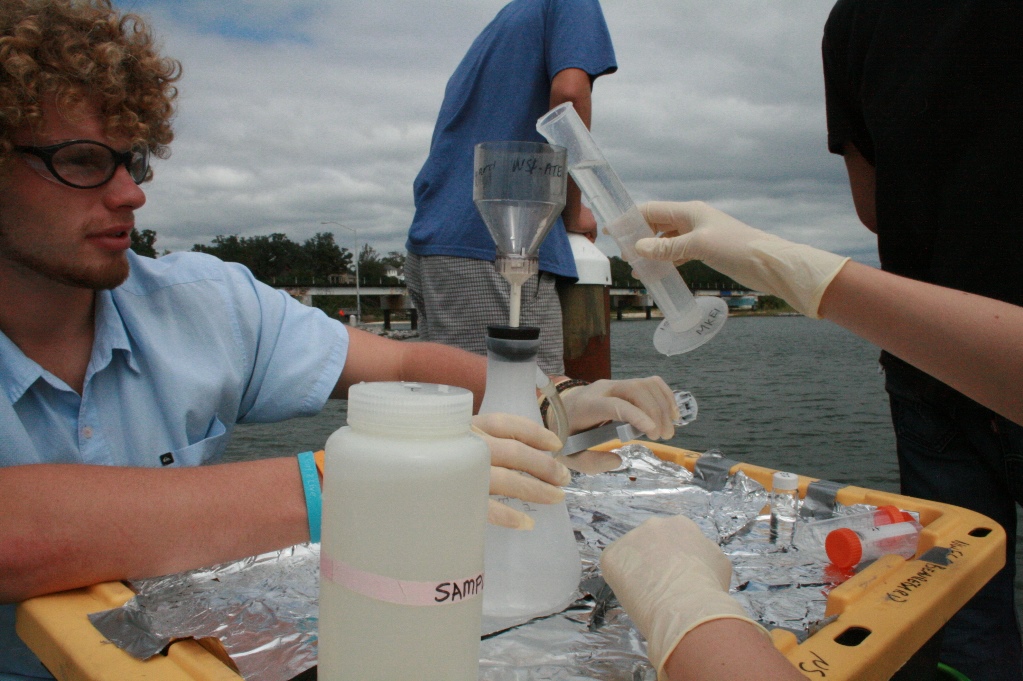When I first joined Florida Sea Grant water quality was, and still is, a big issue in the community. Many remember the 1960s and 1970s when fish kills were common, industrial waste was discharged into local waterways, fish were changing sex in Eleven Mile Creek, and Escambia Bay was listed as one of the nations most polluted bodies of water.

Photo: Marine Science Academy Washington High School
But along came the federal Clean Water Act in 1972 and changes were required that helped reduce some of these point and nonpoint sources of pollution. Today most of the problems are nonpoint, the fish kills are almost nonexistent, but there are still legacy pollutants in the sediments from years of abuse. Overall water quality has improved since the Clean Water Act and concerned citizens, as well as local decision makers, continue to do a lot to help improve our estuary.
As a county Extension Agent, charged with educating the public about the issues and how to resolve them, we have focused on two specific concerns – nutrients and fecal bacteria.
Nutrients can fuel the growth of phytoplankton, which can lead to a decrease in dissolved oxygen, which can lead to fish kills – the primary cause of the fish kills from the past. Though we have not experienced the blooms of harmful (toxic) algae as they are in south Florida currently, we know this could happen here as well. Florida Sea Grant oversees the University of Florida IFAS Lakewatch program here. Lakewatch volunteers monitor for nutrients in assigned locations and also sample for the abundance of phytoplankton. We have been doing this since 2002 and the current data suggest that most of the bodies of water we are monitoring are what we call mesotrophic – right in the middle. Estuaries are typically higher in nutrients than area freshwater systems, and nutrients are expected in estuaries.
We have also monitored the frequency of fish kills using FWCs website, and fish kills have been basically nonexistent over the last decade. That said, two area waterways – Bayou’s Chico and Texar – do have high enough nutrient loads to be labeled eutrophic – nutrient high. Though the fish kills are not occurring, efforts to reduce nutrients in these waterways is recommended, and there are efforts to do just that.
There is a fecal bacteria issue. The Florida Department of Health monitors fecal bacteria levels at local swimming areas. They are currently monitoring 13 such beaches but they do not monitor them equally. Because of cost, they usually only monitor beaches during the warmer months when people may actually be swimming, and some of those are not every week. If a sample indicates 71 colonies of Enterococcus bacteria, or more, a second sample is collected to confirm. If 71 or more colonies is confirmed a health advisory is issued. Because they do not sample each location equally, we report the percent of samples collected requiring an advisory – instead of the number of advisories. For most locations, 10% or less of the samples require an advisory – many are less than 5% and 0% is not uncommon along the barrier islands. However, the bayous are usually 30% or above. Bayou Grande is usually at or near 30%, Bayou Texar is usually between 30-40%, and Bayou Chico is usually between 50-60%.
The high levels of fecal bacteria in our bayous can be connected to poorly maintained septic systems and sanitary sewage overflows. Within the city there has been an effort to convert some communities over to sewer, but sanitary sewage overflows can/do occur as well. Old pipes, cracked septic tanks, and the items people pour down the drains can account for the high levels in our bayous. This year seems to be a good year. All water bodies are below 30% except Bayou Chico, who JUST passed the 30% mark (33%) this month and has been below the rest of the year. Time will tell if there is a downward trend in health advisories, but system maintenance is still needed by everyone.
Though water quality problems still occur in our estuary, things have certainly improved since the 1960s. Continued work in this area will only improve things more. To learn how you can help improve water quality in our bay contact your local county extension office.
 0
0
